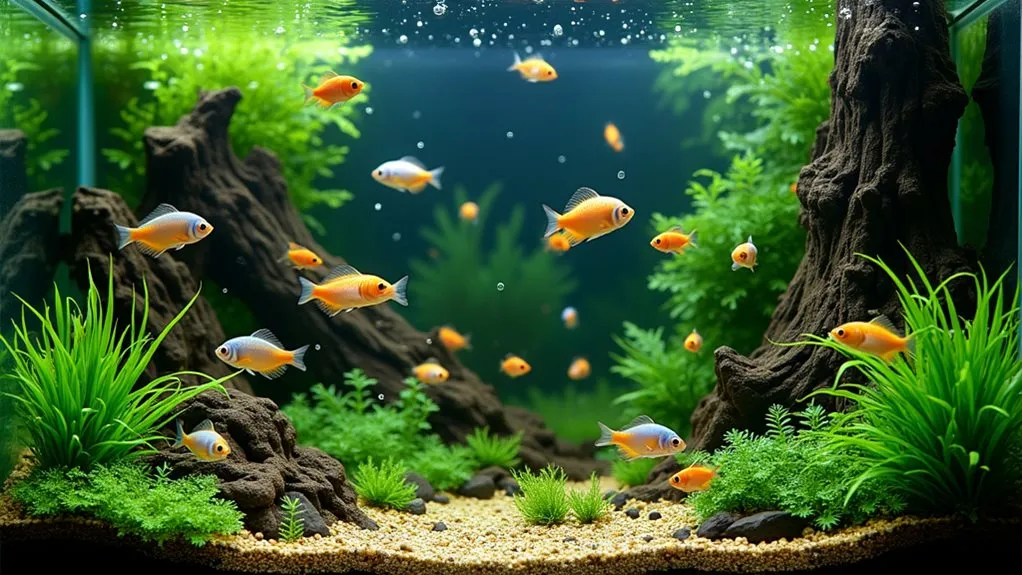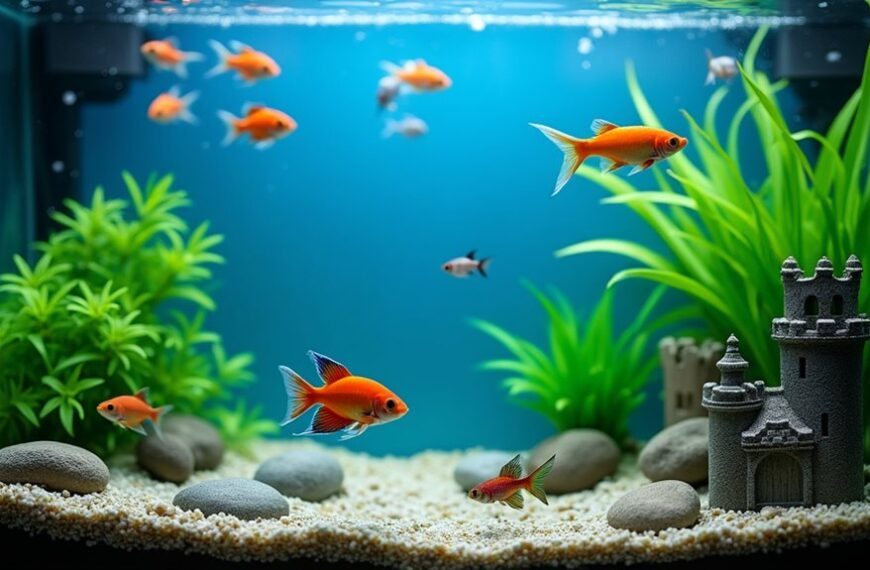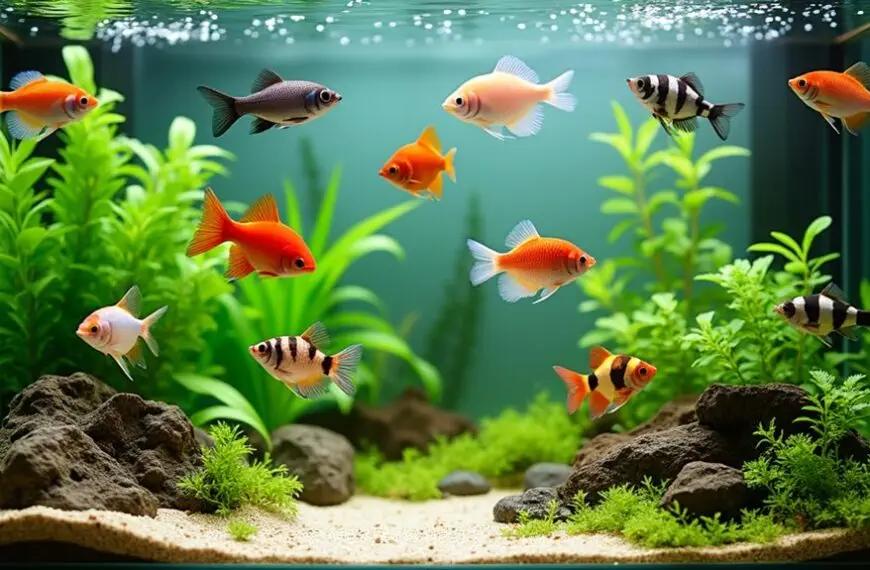To successfully mix fish species, you’ll need to match temperaments, water parameters, and feeding habits. Choose peaceful community fish with similar pH and temperature needs (typically 74-78°F, pH 6.5-7.5). Provide adequate space—at least 1 gallon per inch of adult fish—and create distinct territories using plants and decorations. Pair top feeders with bottom dwellers for balanced nutrition, and monitor for signs of aggression like nipped fins. The right combination transforms your tank into a thriving underwater community.
Contents
- 1 Understanding Fish Temperament and Social Behavior
- 2 Water Parameter Compatibility Among Species
- 3 Space Requirements for Mixed Community Tanks
- 4 Selecting Compatible Feeding Habits
- 5 Creating Distinct Territories With Aquascaping
- 6 Identifying Compatible Fish Groups by Region
- 7 Monitoring and Managing Aggression Signs
- 8 Quarantine Protocols Before Adding New Species
- 9 Frequently Asked Questions
- 9.1 How Many Fish Species Can I Safely Mix in One Aquarium?
- 9.2 Can Coldwater and Tropical Fish Species Live Together Successfully?
- 9.3 How Do I Introduce New Fish to an Established Community Tank?
- 9.4 Should I Add All Mixed Species at Once or Gradually?
- 9.5 Will Breeding Occur Between Different Compatible Species in My Aquarium?
- 10 Final Thoughts
Understanding Fish Temperament and Social Behavior
When you’re planning to create a community aquarium, understanding the unique personalities and social dynamics of fish species becomes your first crucial step.
Just like people, fish have distinct fish personalities that influence how they’ll interact with tank mates. Some species are naturally peaceful schooling fish that thrive in groups, while others might be territorial loners who’ll defend their space aggressively.
You’ll need to recognize these traits before making purchases to avoid future conflicts.
Social hierarchies develop quickly in aquariums, with dominant fish often claiming prime territory and feeding positions.
These underwater power structures can work harmoniously if you’ve selected compatible species with similar water parameters and environmental needs. Additionally, it’s essential to remember that schooling behavior enhances fish well-being, as certain species require companionship to thrive.
Don’t worry—you don’t need a fish psychology degree! With careful research and observation, you’ll soon understand which personalities make good neighbors and which need their own space.
Water Parameter Compatibility Among Species
You’ll need to match your fish’s water parameter needs, as different species thrive in specific pH and temperature ranges.
When you’re selecting tankmates, consider both the pH (acidic, neutral, or alkaline) and temperature preferences to guarantee everyone’s comfort in their shared home.
Hardness compatibility matters too, since soft-water species like tetras won’t flourish in the calcium-rich conditions that African cichlids crave, creating stress that can lead to illness and shortened lifespans. Additionally, maintaining proper nitrate levels is essential for fish well-being, as high concentrations can cause distress in many species.
Ph and Temperature Ranges
Since different fish species evolved in vastly different waterways around the world, maintaining compatible water parameters becomes absolutely essential for a peaceful community tank.
Your success hinges on matching fish that share similar pH balance and temperature stability requirements. When researching potential tank mates, consider these critical factors:
- pH preferences – Most tropical community fish thrive between 6.5-7.5, but cichlids might prefer 7.8-8.5
- Temperature comfort zones – Typical community tanks operate at 74-78°F, while some species need cooler or warmer conditions
- Consistency matters – Fluctuations stress fish more than slightly imperfect conditions
Additionally, understanding how temperature impacts dissolved oxygen levels is vital for ensuring the health of your aquatic community.
You’ll find that properly matched fish not only survive but truly thrive together.
Trust me, there’s nothing more rewarding than watching a diverse, colorful community swimming happily in your carefully balanced aquatic home!
Hardness Compatibility Matters
Beyond pH and temperature, water hardness plays an essential role in creating a harmonious community tank. Fish have evolved in specific mineral environments, and mixing species with dramatically different hardness requirements can stress or even harm your aquatic friends.
You’ll want to invest in reliable hardness testing kits to regularly monitor your tank’s GH (general hardness) and KH (carbonate hardness) levels.
Many African cichlids thrive in hard, mineral-rich water, while Amazonian species prefer softer conditions with fewer dissolved minerals. If you’re keeping soft-water fish, you might need to use RO (reverse osmosis) water.
For hard-water species, mineral supplementation becomes necessary to maintain appropriate calcium and magnesium levels. Crushed coral substrate or limestone decorations can naturally increase hardness in tanks housing Central American cichlids or livebearers, making maintenance easier for you! Regular water changes can further help balance water quality and ensure optimal conditions for all species.
Space Requirements for Mixed Community Tanks
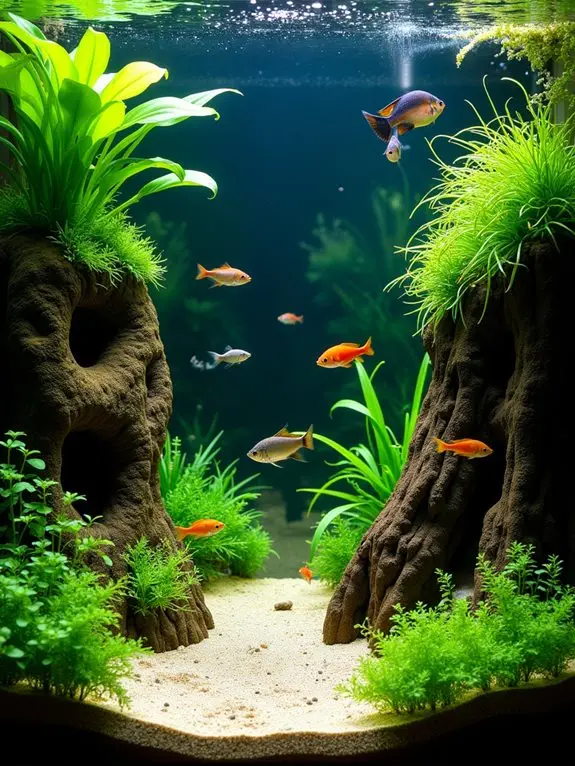
Three essential factors determine the success of a mixed community tank: space, space, and more space!
When you’re planning your aquatic community, remember that proper tank size directly impacts your fish’s health and behavior. Overcrowding leads to stress, aggression, and poor water quality—no matter how efficient your filtration system.
Consider these fundamental space guidelines:
- Allow at least 1 gallon of water per inch of fish (more for active swimmers)
- Factor in adult sizes, not the tiny juveniles you purchase
- Include extra space for decorations, plants, and territorial boundaries
The ideal species density depends on swimming habits and temperament. Moreover, maintaining water quality management is crucial to prevent any deterioration in the living environment.
Bottom-dwellers, mid-water schoolers, and surface swimmers can peacefully coexist when you’ve provided adequate swimming zones for each. Your fish will thank you with vibrant colors and natural behaviors!
Selecting Compatible Feeding Habits
When you’re mixing fish in your aquarium, it’s crucial to take into account different feeding habits, such as pairing top feeders with bottom feeders for balanced nutrition throughout the tank.
You’ll want to match carnivores with herbivores carefully, ensuring the meat-eaters won’t view plant-eaters as their next meal while they peacefully munch on vegetation.
Creating a consistent feeding schedule that accommodates all your fish’s dietary needs will prevent food competition and keep your underwater community thriving together. Including hardy fish like common goldfish can help maintain stability in your tank environment.
Top vs. Bottom Feeders
Understanding where your fish prefer to feed in the aquarium can make or break your community tank’s harmony. Creating a balanced ecosystem means considering both top feeder advantages and bottom feeder benefits when stocking your aquarium.
Top feeders, like guppies and danios, help keep the water surface clear of debris, while bottom dwellers like corydoras and loaches scavenge uneaten food that sinks to the substrate. This natural division of feeding zones reduces competition and stress among tankmates.
For ideal feeding success in a mixed community:
- Offer floating foods for surface swimmers when bottom feeders are hiding
- Use sinking pellets or wafers to guarantee bottom feeders get their share
- Observe feeding behaviors after introducing new species to confirm everyone’s getting enough
By ensuring minimum tank sizes are followed, you can help maintain a stable environment where both top and bottom feeders thrive. With thoughtful planning, you’ll create a thriving community where everyone gets their fair share!
Carnivores With Herbivores
Mixing carnivores with herbivores requires careful consideration to guarantee peaceful coexistence in your community tank. While these different feeding types can actually complement each other in the wild, your aquarium creates a confined environment where carnivore compatibility becomes essential.
You’ll want to select meat-eaters that aren’t aggressive toward tank mates or small enough to become snacks!
For successful herbivore dynamics, make sure you’re providing ample plant matter and algae-based foods. Many hobbyists find that feeding carnivores separately (perhaps at night) reduces competition and stress. Additionally, consider the optimal pH levels for your fish species to ensure a healthy environment.
Remember that some “carnivores” are opportunistic feeders who might nibble on plants when hungry, while certain “herbivores” won’t pass up protein-rich treats occasionally.
The key is research—know your specific species’ temperaments and true dietary needs before creating your underwater community.
Feeding Schedule Considerations
Creating harmonious feeding schedules makes all the difference in a multi-species aquarium‘s success. When you’ve got fish with different eating habits sharing the same tank, you’ll need to develop a strategy that guarantees everyone gets their fill without causing chaos at mealtime.
Consider these key approaches to feeding your diverse aquatic community:
- Adjust feeding frequency based on each species’ natural habits—some need multiple small meals while others thrive on once-daily feedings.
- Provide dietary variety through specialized foods that sink, float, or attach to surfaces so all fish can access appropriate nutrition.
- Create feeding zones in different areas of the tank to minimize competition and aggression during mealtimes.
- Additionally, observing peaceful community dynamics can help you assess how well your fish interact and adjust feeding strategies accordingly.
You’ll find that with thoughtful planning, even fish with competing feeding behaviors can peacefully coexist in your carefully balanced underwater world.
Creating Distinct Territories With Aquascaping
Thoughtful aquascaping stands at the heart of a peaceful multi-species aquarium.
When you’re mixing different fish, creating distinct territories isn’t just decorative—it’s essential for reducing aggression and stress. Territorial species like cichlids or bettas need clearly defined spaces they can claim as their own.
You can achieve this with strategic placement of rocks, driftwood, and plants.
Try creating “rooms” within your tank using tall plants as natural dividers. Breaking the line of sight between territories helps prevent confrontations between fish that might otherwise challenge each other. Additionally, selecting the right substrate can play a key role in fostering a beneficial ecosystem that supports the overall health of your fish and plants.
Identifying Compatible Fish Groups by Region
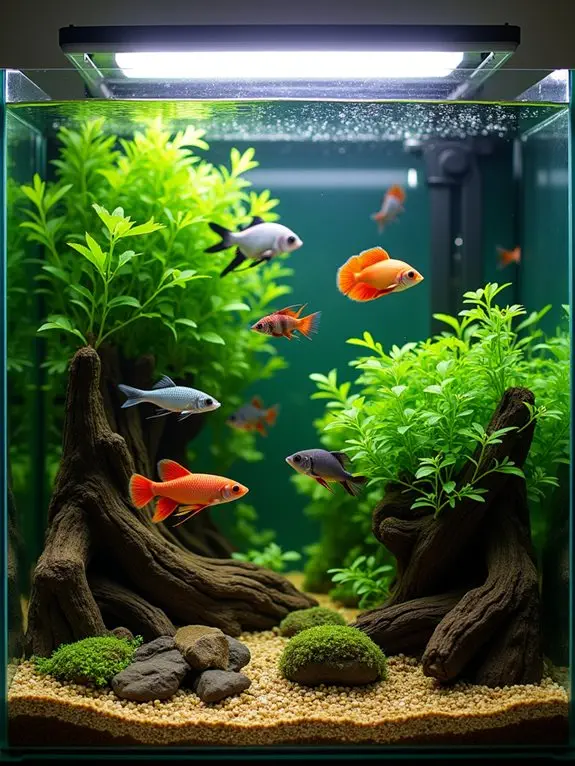
Beyond physical territories, a fish’s geographic origin plays a key role in determining compatibility. When exploring regional fish diversity, you’ll discover natural companions that have evolved together in the wild.
Creating a regionally-themed tank often yields better success than mixing fish from different continents, as they share similar habitat preferences and water parameters.
Consider these regional groupings for your aquarium:
- South American community: Tetras, angelfish, and peaceful catfish thrive together in soft, slightly acidic water
- African cichlid setup: Vibrant Malawi or Tanganyika cichlids coexist when given proper rock structures
- Southeast Asian collection: Gouramis, barbs, and rasboras appreciate planted environments with gentle water flow
You’ll find that respecting these natural geographic boundaries not only creates a more authentic display but also greatly reduces stress and aggression among your aquatic pets.
Monitoring and Managing Aggression Signs
Even in the most carefully planned community tanks, unexpected aggression can develop as fish establish their hierarchy or respond to changing conditions.
You’ll need to watch for common aggression triggers like overcrowding, limited hiding spots, or feeding competition that can turn your peaceful aquarium into a battleground.
Learn to recognize stress indicators early: nipped fins, fish hiding constantly, rapid breathing, or color fading often signal trouble brewing.
If you notice these warning signs, don’t wait for the situation to escalate. Try rearranging decorations to break territorial lines of sight, add more hiding places, or consider a larger tank.
In severe cases, you might need to separate the aggressor using a tank divider or rehome particularly hostile fish.
Quarantine Protocols Before Adding New Species
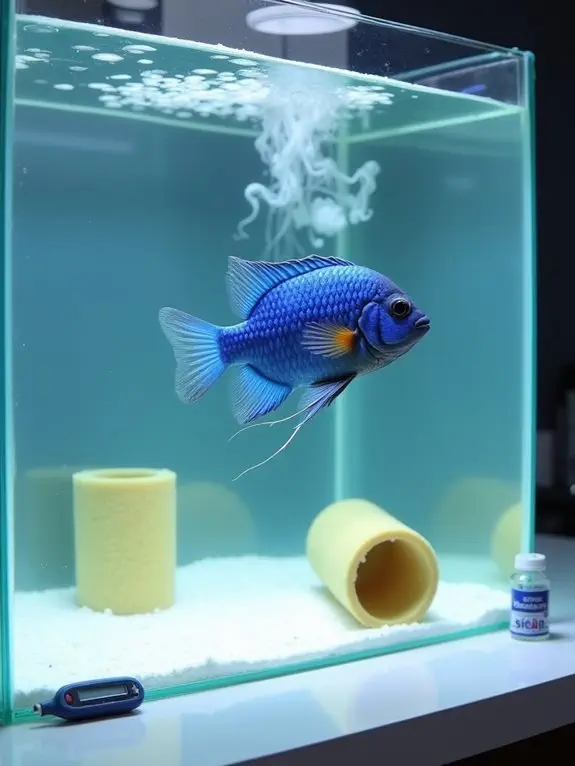
Before introducing new fish to your established aquarium, implementing a proper quarantine period can mean the difference between a thriving community and widespread disease.
You’ll want to maintain a separate quarantine tank for at least 2-4 weeks, which is the ideal quarantine duration for observing potential health issues without risking your main tank.
Follow these steps for effective disease prevention:
- Set up a simple quarantine tank with basic filtration, hiding spots, and similar water parameters as your main tank.
- Monitor new arrivals daily for unusual behaviors, spots, or symptoms.
- Treat any issues in the quarantine tank where medications won’t harm beneficial bacteria in your main system.
You’ll thank yourself later when your carefully quarantined newcomers integrate smoothly into your aquatic community without bringing unwanted hitchhikers along!
Frequently Asked Questions
How Many Fish Species Can I Safely Mix in One Aquarium?
You can safely mix 3-5 compatible species in one aquarium, depending on your tank size. Don’t overcrowd. Research each fish’s requirements before purchasing to guarantee they’ll thrive together in your specific setup.
Can Coldwater and Tropical Fish Species Live Together Successfully?
No, you shouldn’t mix coldwater and tropical fish due to poor coldwater compatibility. Tropical requirements include consistent higher temperatures (75-80°F), while coldwater species thrive in 60-72°F. These opposing needs create unhealthy conditions for both.
How Do I Introduce New Fish to an Established Community Tank?
You’ll need to follow a proper quarantine process first. Watch your new fish’s behavior in isolation for 2-3 weeks before slowly introducing them to your established tank during feeding time.
Should I Add All Mixed Species at Once or Gradually?
Add new fish gradually, not all at once. You’ll reduce stress and allow tank dynamics to stabilize. This approach gives you time to observe fish behavior and address any compatibility issues before introducing more species.
Will Breeding Occur Between Different Compatible Species in My Aquarium?
Breeding between compatible species rarely occurs naturally in home aquariums. You’ll notice breeding behavior only if species are closely related. Most fish require specific conditions to reproduce, which your community tank likely doesn’t provide.
Final Thoughts
You’ve now got all the tools to create a thriving multi-species aquarium! Remember, success comes from research and patience, not rushing the process. Watch your tank daily, be ready to make adjustments, and you’ll enjoy the beautiful diversity of your underwater community. The reward of seeing different fish species swimming harmoniously together makes all your careful planning worthwhile. Happy fish keeping—your aquatic adventure is just beginning!

